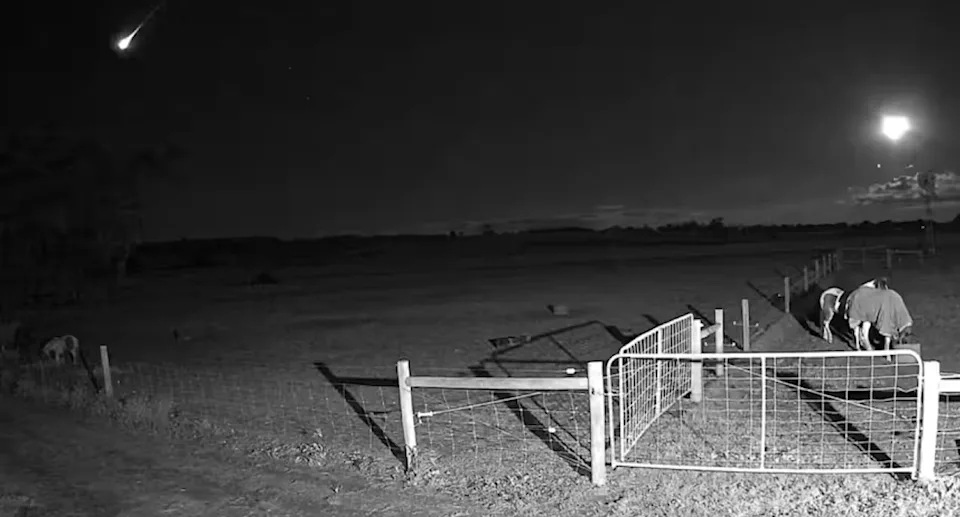
A small rock streaked across the Victorian sky and vanished almost as quickly as it appeared.
Scientists are now racing against time to track down its landing spot.
Its journey from deep space to Earth has captured the imagination of researchers and locals alike.
In the days following the fall of an ‘extremely valuable’ meteorite, experts from Monash University pinpointed its collision to a 1km by 3km patch of farmland in central Victoria.
Dr Rachel Kirby, a geochemist at Monash, said the meteorite could be 4.5 billion years old, predating the Earth itself. ‘It has the story of our solar system recorded in it,’ she shared.
The team aimed to study the rock to better understand the composition of the solar system without relying on costly spacecraft missions.
Source: Youtube/Guardian Australia
Using the Desert Fireball Network, which specialises in meteorite detection, researchers in Victoria collaborated with a Curtin University expert across the continent.
They calculated the meteorite had likely originated in the inner asteroid belt, 179.5 to 329 million kilometres away, before entering Earth’s path.
The rock is composed of iron, nickel and rocky fragments, but its exact location posed a challenge due to the farmland terrain.
Home security footage captured the meteorite falling on 10 August. Cameras around Bendigo and Ballarat recorded its bright descent as it entered the atmosphere.
‘You can see it stop burning up in the sky, then it falls to the ground like it’s been dropped from a tall building. The atmosphere really slows it down, so it might be in a small hole, or sitting closer to the surface.’
Researchers have spent the past week scouring paddocks for the meteorite. Enthusiasts from the public also joined the search, though a few landowners denied access, leaving the possibility it might never be recovered.
Locating the meteorite is made harder because it weighs just 1 to 3kg and is no bigger than a grapefruit.
Did you know?
Did you know? Most suspected meteorites brought to museums turn out to be ‘meteor-wrongs’—terrestrial rocks that look space-like but aren’t. Even experienced geologists can be fooled by certain iron-rich rocks or slag from old industrial sites.
Kirby noted the difficulty of distinguishing it from common paddock objects. ‘From a distance, animal poo looks a lot like a meteorite, especially when it’s fresh. It’s dark, and shiny, and round. Cow poos are a little bit easier to tell apart, but when it comes to horses, it’s a challenge,’ she said.
Locals have mostly welcomed the scientists, who take care to work safely in the fields. Kirby’s previous expeditions included a major search in Antarctica, and she has first-aid training and experience in remote environments.
Australian meteorite ownership laws
Western Australia & South Australia: Meteorites belong to the state government
Queensland & NSW: ‘Finders keepers’ generally applies
Victoria: Laws unclear, but may follow ‘finders keepers’ principle
All states: Cannot export meteorites without federal permits
The current expedition coincided with sunnier weather, prompting the team to stay alert for snakes and wear high boots.
The next search is scheduled for the Nullarbor Plain, a vast arid region in southern Australia.
Holding a meteorite remains a profound experience for Kirby. ‘We’re a very small planet in our solar system. Most of our solar system is a vacuum; there’s a lot of space between planets. And then a small rock happened to have its path align with ours, and we met in space, and it landed on the Earth,’ she said.
‘That’s just unlikely and really fortunate.’
What This Means For You
Scientists have pinpointed the likely landing site of a meteorite to a 1km by 3km patch of farmland in central Victoria. This rock, estimated to be 4.5 billion years old, could offer an unprecedented glimpse into the early history of our solar system.
Its small size and resemblance to horse droppings, however, make it extremely difficult to locate. The researchers, experienced in remote and challenging conditions, plan to continue their search in other areas, including the vast Nullarbor Plain.
This extraordinary find is a reminder of the rare and remarkable events that can happen in everyday life, right in our own backyard. Holding or even just witnessing something older than the Earth itself connects us to a bigger story, one that stretches across billions of years and reminds us of the wonder still to be discovered.
‘Fat as anything’: Meteor lights up Victorian skies as experts try to locate crash site — Reports on witnesses hearing a loud bang, feeling the ground shake, and describing the meteor as a shimmering fireball.
https://www.sbs.com.au/news/article...as-experts-try-to-locate-crash-site/nknl18paf
Meteor lights up Victoria's night sky, causes social media stir — Covers the bright fireball, loud boom, and widespread attention on social media.
https://www.bendigoadvertiser.com.a...victorias-night-sky-causes-social-media-stir/
‘Huge explosion’: Confusion as meteor shakes Victoria — Victorian residents reported homes shaking as a flaming ball streaked across the sky on 10 August.
https://www.thenewdaily.com.au/news/state/vic/2025/08/11/meteor-western-victoria
Desert Fireball Network: Home — Overview of the DFN, its mission to detect meteors, and the network of autonomous cameras for tracking falls.
https://dfn.gfo.rocks/
Observation of metre-scale impactors by the Desert Fireball Network | Monthly Notices of the Royal Astronomical Society — Describes the detection of low-mass meteoroids and their potential to cause ground damage.
https://academic.oup.com/mnras/article/483/4/5166/5256650
Meteorite fall zone identified northeast of Maryborough, Victoria after August 10 fireball — Identifies the probable fall zone using triangulated video and sensor data.
https://watchers.news/2025/08/15/meteorite-fall-zone-maryborough-victoria-august-10-fireball/
If a meteorite is found on your land, do you own it? — Discusses ownership rules for meteorites found in Australia.
https://www.skyatnightmagazine.com/space-science/meteorite-ownership
Australian Federal Meteorite Law—Meteorites Australia — Outlines federal laws preventing export and state-specific ownership rules for meteorites.
http://www.meteorites.com.au/found/law.html
Found A Meteorite? (Meteorite Identification Information & Help) - Meteorites Australia — Provides guidance on identifying meteorites and legal considerations for finders.
http://www.meteorites.com.au/found.html
Meteorite found by gold prospector—the first found in Victoria since 1995—comes to Museums Victoria — Details the discovery of a 17kg meteorite in Maryborough in 2015 and its scientific significance.
https://museumsvictoria.com.au/medi...ictoria-since-1995-comes-to-museums-victoria/
Meteorite Regulations? | Prospecting Australia—Gold Prospecting & Fossicking Forum — Discusses state regulations regarding meteorite ownership and historical finds in Australia.
https://www.prospectingaustralia.com/threads/meteorite-regulations.1840/
Could a tiny rock from billions of years ago really hold the secrets of our solar system in the palm of your hand?







